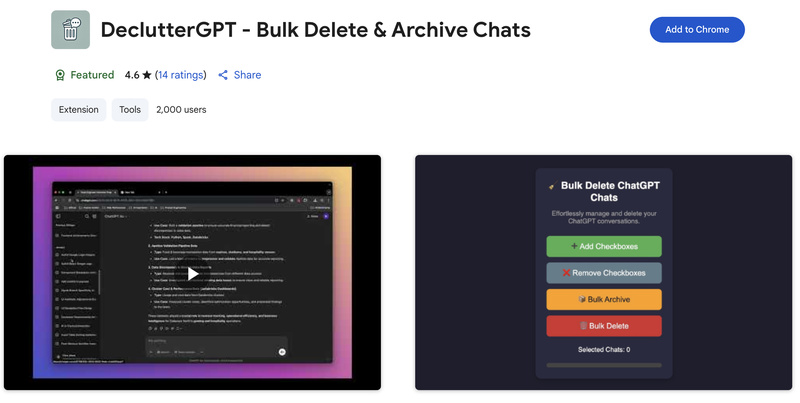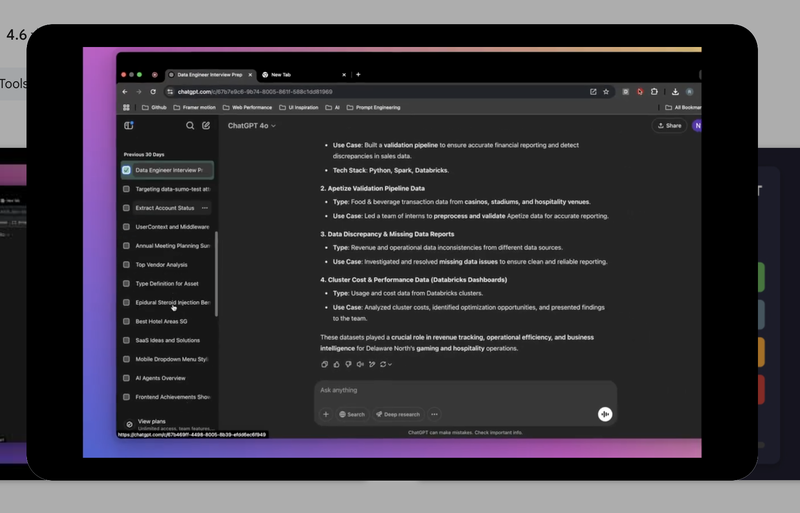How a ChatGPT Chrome Extension Grew to 2,000+ Users Without Spending a Dollar on Marketing
Summary
DeClutterGPT helped ChatGPT users bulk-delete conversations in a simple, intuitive way. The founder found the problem through community forums, validated the demand quickly, and built a focused Chrome extension that launched directly into threads where users already talked about the issue.
Actionable Takeaways:
- Search Reddit, Hacker News, and Twitter to find real problems users complain about
- Build the lightest version of your product to test whether the problem resonates
- Launch directly in threads where users are discussing the pain, not just on launch platform.
- Apply for built-in discovery boosts like Chrome’s featured badge
- Keep your product simple, clear, and focused on one key job
Introduction
Deleting ChatGPT conversations one by one was a frustrating workflow issue for many users. The founder of DeClutterGPT recognized this problem early when trying to bulk delete his own chats, validated it by searching through Reddit and Hacker News threads, and built a minimal Chrome extension that solved it directly. Without any paid marketing, DeClutterGPT reached over 2,200 users by focusing on community-driven growth and product clarity.

Identify the Pain From the Start
The idea for DeClutterGPT came from a daily frustration. The founder used ChatGPT often and noticed how quickly conversations piled up. Deleting them one at a time was slow and inefficient.
Before building anything, he wanted to know if others felt the same pain. He went to Reddit and searched terms like:
- “delete conversations on chatGPT site:reddit.com”
- “clear chatgpt history bulk”
He found multiple threads where users were asking for a better way to manage or delete conversations. That was enough to confirm the problem was real and widespread.
He also checked Hacker News and found users mentioning the same issue in larger ChatGPT-related discussions. There was no native solution and no reliable workaround.
Build the Smallest Useful Thing First
He kept it lean. No signup. No backend. Just front-end code running inside the browser.
Choosing a Chrome extension made it easy to:
- Build and test quickly
- Avoid needing API access from OpenAI
- Deploy without user friction
It was live within a few days and worked directly with the existing ChatGPT interface.
Launch in the Right Place, Not the Loudest One
Rather than doing a full launch on Product Hunt or sending it to his email list, the founder went back to the same Reddit threads where people had complained about the issue.
He left a short, helpful comment:
- A quick demo showing what the extension looked like
- A direct link to the Chrome Web Store listing
- A one-line description of what it did
Because the post responded to real user complaints, it didn’t feel like promotion. It felt like a fix.
Users responded with comments, upvotes, and most importantly, installs. This early traction gave him enough signal to keep improving the extension.

Use Built-In Distribution From the Platform
Once the extension had a few hundred users and positive reviews, he applied for a featured badge on the Chrome Web Store. This is a badge that highlights quality extensions in search results and category pages.
To qualify, he made sure the listing was:
- Clear and descriptive
- Visually clean, with good screenshots and a video demo
- Compliant with Chrome’s technical guidelines
After the badge was approved, organic installs increased steadily without additional promotion. Chrome’s discovery engine brought in new users every day.
This let him shift his focus from awareness to retention and feedback.

Keep the Product Focused and Simple
The extension was built to solve one job. That focus helped users understand the value immediately.
There were no extra settings, no analytics layer, and no distractions. Users could open the extension, preview their conversation list, select chats, and delete in bulk.
This simplicity was intentional. It allowed him to ship updates quickly and avoid bugs that come from over-building too soon.
I didn’t guess what to build. I searched Reddit and Hacker News to see what people were already complaining about.
Advice for Other Builders
The founder’s playbook was simple:
“I didn’t guess what to build. I searched Reddit and Hacker News to see what people were already complaining about.”
From there, he followed a lightweight process:
- Search where people complain and find a repeatable problem
- Build the smallest thing that solves it cleanly
- Launch directly in the threads where the pain is being discussed
- Use the platform itself (in this case, Chrome) as a growth channel
- Stay focused and improve based on user feedback, not assumptions
There was no marketing plan. No launch checklist. Just clear execution tied to a known problem.